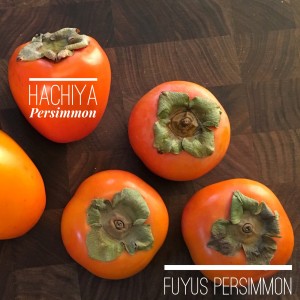Persimmons are a gorgeous winter fruit perfect for eating raw. This Northern California fruit thrives in cold weather and is in peak season from October to December. Persimmons have the texture of a cantaloupe and taste like a sweet pumpkin with a dash of cinnamon. Looking into the history of persimmons, Pilgrims in North America would often use persimmons to make alcoholic beverages, like beer and wine.
There are two types of persimmons, the hachiya and fuyus. The hachiya persimmons are shaped like an acorn and have been known to cause a puckering dry mouth effect if eaten before they’ve fully softened. Persimmon puckering occurs because of the astringent content of the hachiya, mostly caused by its high tannin content. It’s tannic quality if akin to the most tannic glass of wine you ever drank and had to spit out. On the other hand, the fuyus persimmons are shaped like an heirloom tomato and have almost no tannins and cause little to no puckering like the hachiya, so they can be eaten before they’ve fully ripened.
When eating a persimmon some people remove its outer skin, however the skin holds most of a persimmon’s antioxidants and fiber content. Persimmons are full of fiber with one medium sized persimmon containing 6 grams of fiber, which is twice the amount of fiber of an apple, more fiber than a ½ cup of black beans, and has 55% of your daily vitamin A needs.
When selecting persimmons the hachiya should to be purchased soft and when you can make a slight indentation on the skin when pressed. Fuyus persimmons have a tough skin, which don’t soften much as they ripen but you can enjoy them before they are fully ripened.
- Persimmon ripeness rule of thumb: always wait to eat a hachiya until it is fully soft, however the fuyus can be enjoyed before it’s fully ripened.
- Letting the persimmons breathe in open air is best to encourage the ripening process and maximize their sweetness.
- Your persimmon is ready when it is soft and dents in a little bit when pressing on the persimmon skin.








